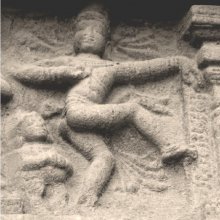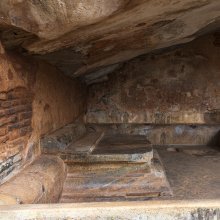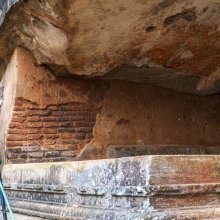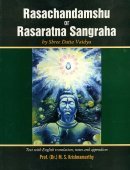Ushe, Uṣe: 2 definitions
Introduction:
Ushe means something in biology. If you want to know the exact meaning, history, etymology or English translation of this term then check out the descriptions on this page. Add your comment or reference to a book if you want to contribute to this summary article.
Images (photo gallery)
(+23 more images available)
Biology (plants and animals)
Source: Google Books: CRC World Dictionary (Regional names)1) Use in Angola is the name of a plant defined with Hibiscus cannabinus in various botanical sources. This page contains potential references in Ayurveda, modern medicine, and other folk traditions or local practices It has the synonym Abelmoschus verrucosus (Guill. & Perr.) Walp. (among others).
2) Use is also identified with Hibiscus nigrocaulis It has the synonym Hibiscus cannabinus var. viridis A. Howard & G. Howard (etc.).
3) Use is also identified with Hibiscus sabdariffa It has the synonym Hibiscus gossypiifolius Mill. (etc.).
Example references for further research on medicinal uses or toxicity (see latin names for full list):
· Allgemeine MedizinischPharmazeutische Flora (1857)
· FBI (1874)
· The Sherbro of Sierra Leone. (1938)
· Annuaire du Conservatoire et Jardin Botaniques de Genève (1916)
· Tentamen Florae Abyssinicae (1847)
· Niger Flora (1849)
If you are looking for specific details regarding Use, for example side effects, pregnancy safety, chemical composition, health benefits, diet and recipes, extract dosage, have a look at these references.

This sections includes definitions from the five kingdoms of living things: Animals, Plants, Fungi, Protists and Monera. It will include both the official binomial nomenclature (scientific names usually in Latin) as well as regional spellings and variants.
Languages of India and abroad
Kannada-English dictionary
Source: Alar: Kannada-English corpusUṣe (ಉಷೆ):—
1) [noun] the early morning preceding the sun-rise.
2) [noun] the Hindu goddess of dawn, breath of life of the Vēdas, and corresponding to Roman Aurora and Eos of Greek.
3) [noun] the quality or fact of burning.
4) [noun] a boiler or cooking vessel.
Kannada is a Dravidian language (as opposed to the Indo-European language family) mainly spoken in the southwestern region of India.
See also (Relevant definitions)
Starts with: Usheera, Ushegata, Ushenya, Ushesha.
Ends with (+13): Akalushe, Bhaushe, Bhushe, Cushe, Dakushe, Darushe, Doddakushe, Dushe, Farin baushe, Gamdushe, Kamthabhushe, Keshabhushe, Kushe, Mahapurushe, Mamjushe, Mushe, Niramkushe, Nirmanushe, Nishpurushe, Parushe.
Full-text (+4778): Upayoga, Upabhoga, Viniyoga, Bhuj, Paribhoga, Sambhoga, Anukalpa, Prayojana, Sevaka, Ushesha, Upabhokta, Bhokta, Pulinda, Bhogavata, Prakrita, Avritti, Samseva, Tagavinem, Pravrittinimitta, Dravyaprayojana.
Relevant text
Search found 510 books and stories containing Ushe, Uṣe, Use; (plurals include: Ushes, Uṣes, Uses). You can also click to the full overview containing English textual excerpts. Below are direct links for the most relevant articles:
Puranic encyclopaedia (by Vettam Mani)
Vinaya Pitaka (2): Bhikkhuni-vibhanga (the analysis of Nun’ rules) (by I. B. Horner)
The Devi Bhagavata Purana (by Swami Vijñanananda)
Chapter 13 - On the greatness of Bhasma < [Book 11]
Chapter 14 - On the greatness in holding the Bibhūti < [Book 11]
Chapter 15 - On the rules of using the Tripuṇḍra and Ūrdhapuṇḍra marks < [Book 11]
Hanuman Nataka (critical study) (by Nurima Yeasmin)
11. Use of Prākṛta < [Chapter 4]
3. Examination of the Language from Literary Perspective < [Chapter 6]
1. Philosophical Elements in the Hanumannāṭaka < [Chapter 5]
Vernacular architecture of Assam (by Nabajit Deka)
Classification (b): Evolutionary Typologies < [Chapter 3]
Classification (c): Through Building Material < [Chapter 3]
Conservationism, Sustainable Development, and Vernacular Architecture < [Chapter 10]
Manusmriti with the Commentary of Medhatithi (by Ganganatha Jha)
Verse 4.202 < [Section XIV - Other Duties]
Verse 8.144 < [Section XXVI - Pledges (ādhi)]
Verse 8.150 < [Section XXVI - Pledges (ādhi)]
Related products
(+716 more products available)











